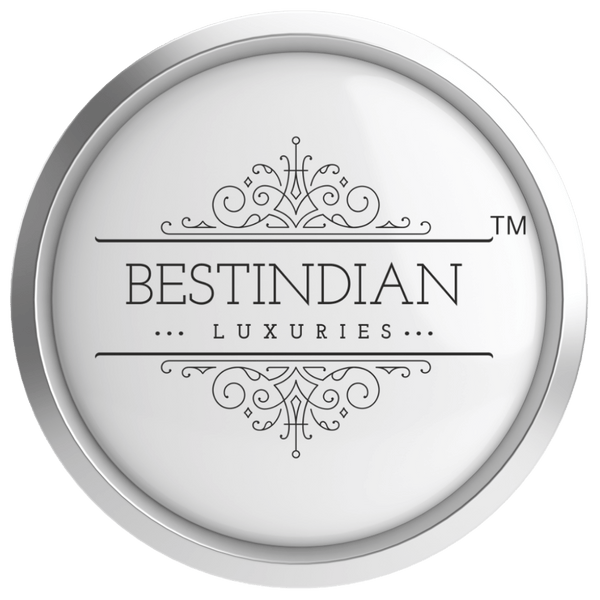BestIndian
Moviestar™ Eye Contour Cream: The Best Under Eye Cream for Dark Circles & Wrinkles in India
Moviestar™ Eye Contour Cream: The Best Under Eye Cream for Dark Circles & Wrinkles in India
Couldn't load pickup availability
Bright eyes, camera-ready. The Moviestar™ Eye Contour Cream is a professional-grade under eye cream for dark circles and puffiness, crafted for the unforgiving eye of the lens—from phone selfies to 8K cinema. This potent Ayurvedic treatment works to counteract the visible effects of screen time, long makeup wear, pollution, and daily stress. Powered by Coffee, Moringa, Almond & Pomegranate oils, its bioactive formula provides targeted hydration to fade the appearance of dark circles, smooth fine lines, reduce puffiness, and firm the delicate eye area. The result? Eyes that look rested, revitalized, and flawlessly camera-ready every morning.
A natural, anti-aging eye cream to visibly reduce dark circles, puffiness, and fine lines for a camera-ready look.
- ⚜️ 100% Natural Formula
- ⚜️ Certified Organic Ingredients
- ⚜️ Cruelty-Free
- ⚜️ Made in the Himalayas
Please Note: Conscious Archive Item (60% Off)
- Manufacturing Date: January 2024
- Best Before: January 2026
- This item is part of our Conscious Archive Sale and is offered at an exceptional 60% discount due to its approaching best before date. It is final sale.

EYE CONTOUR CREAM
Share
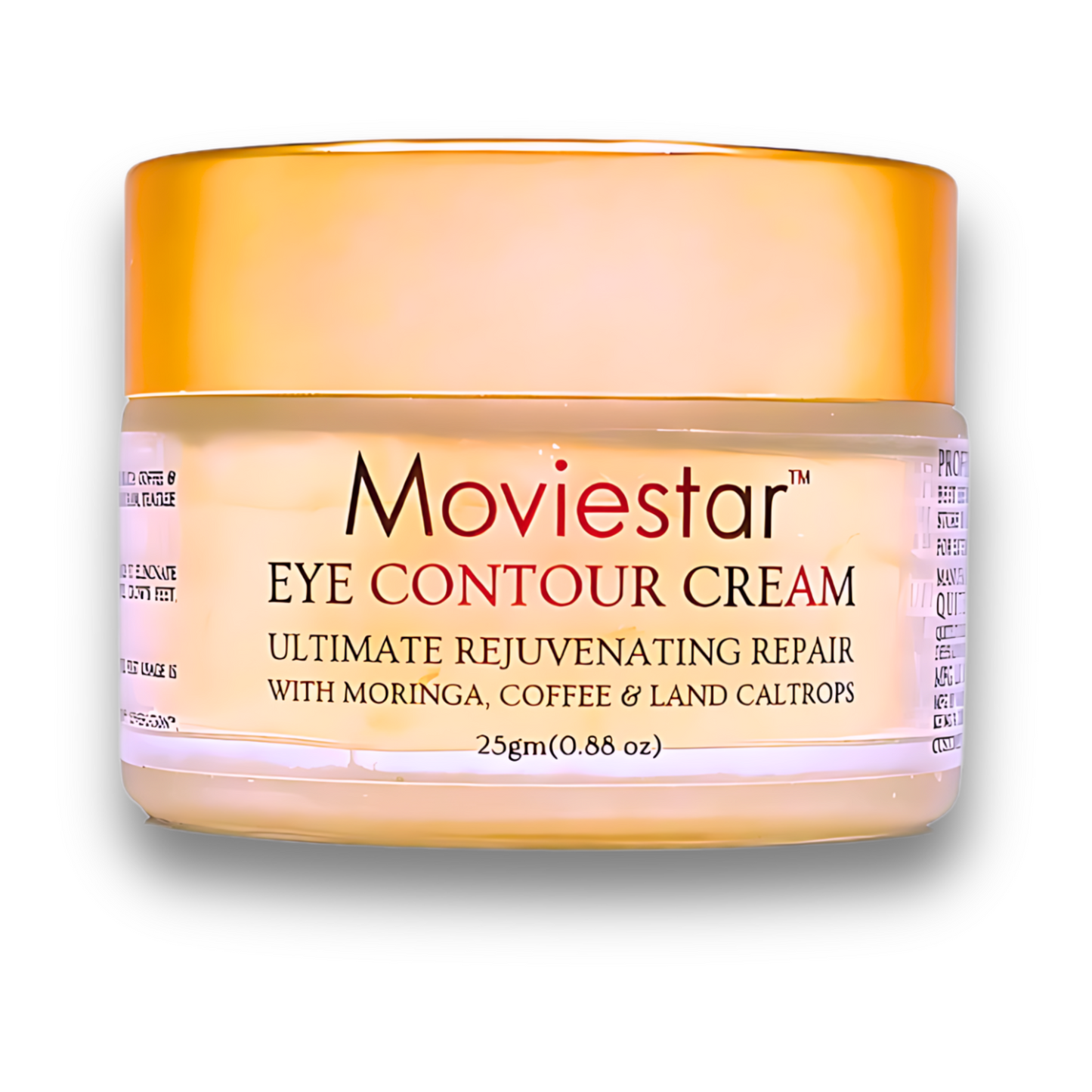

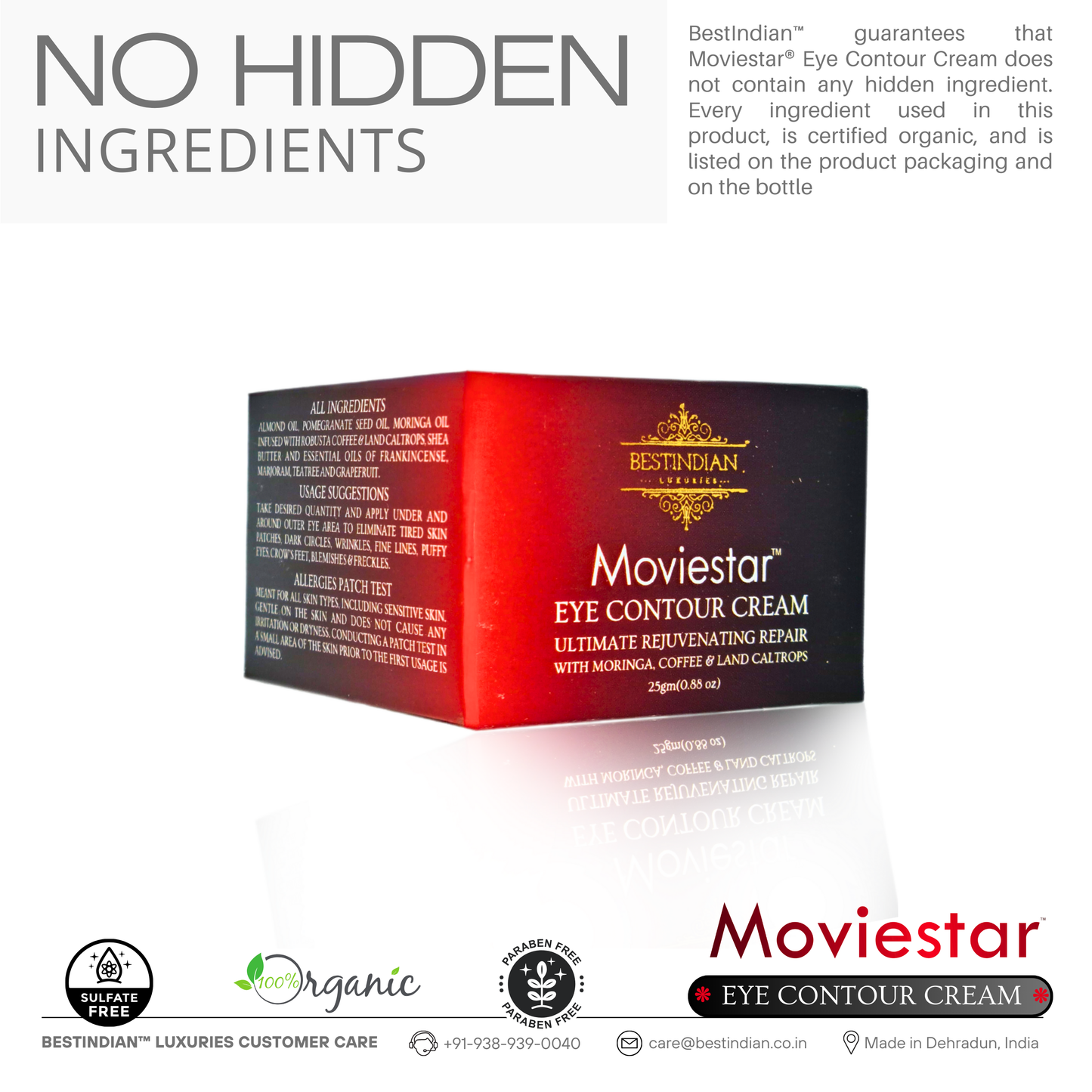
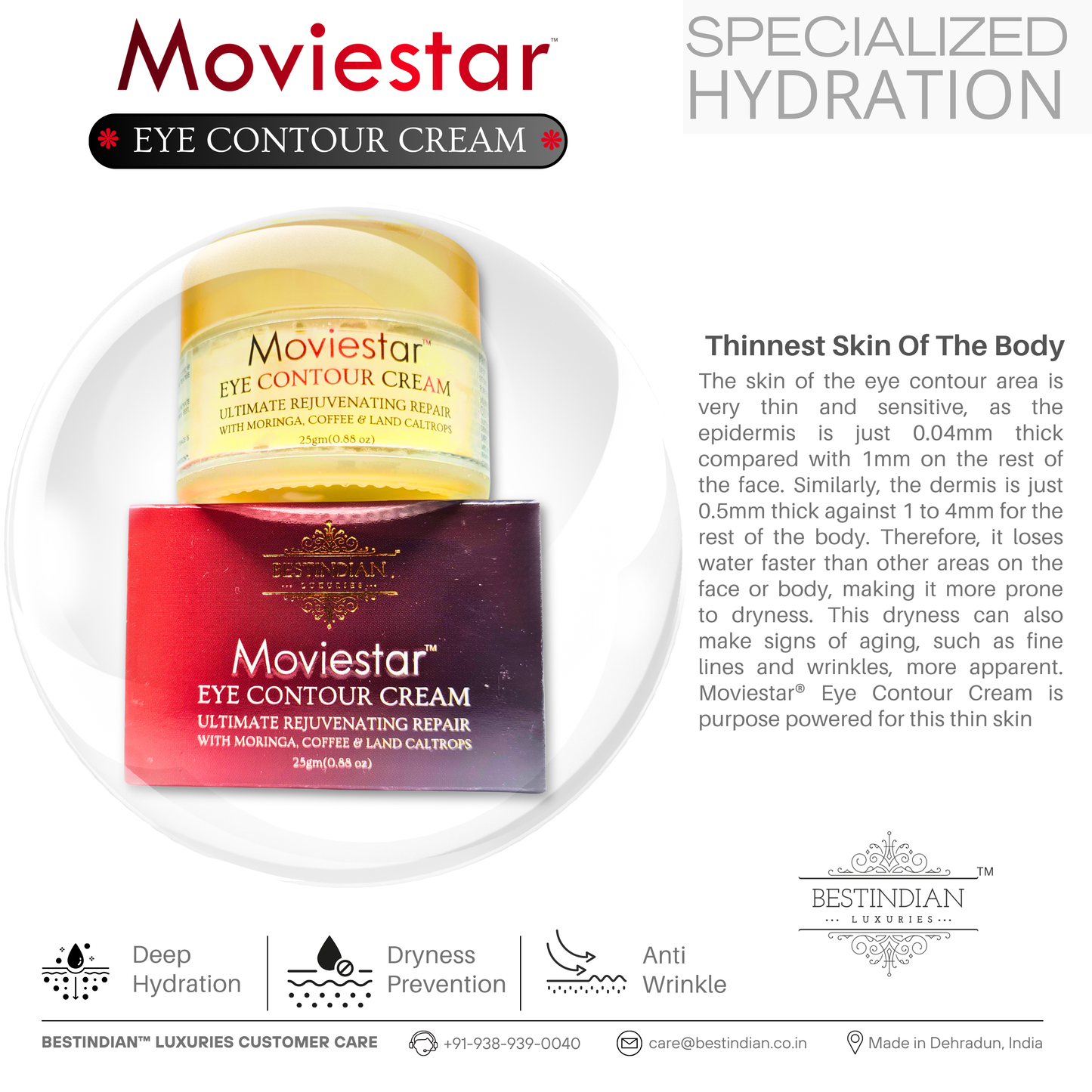
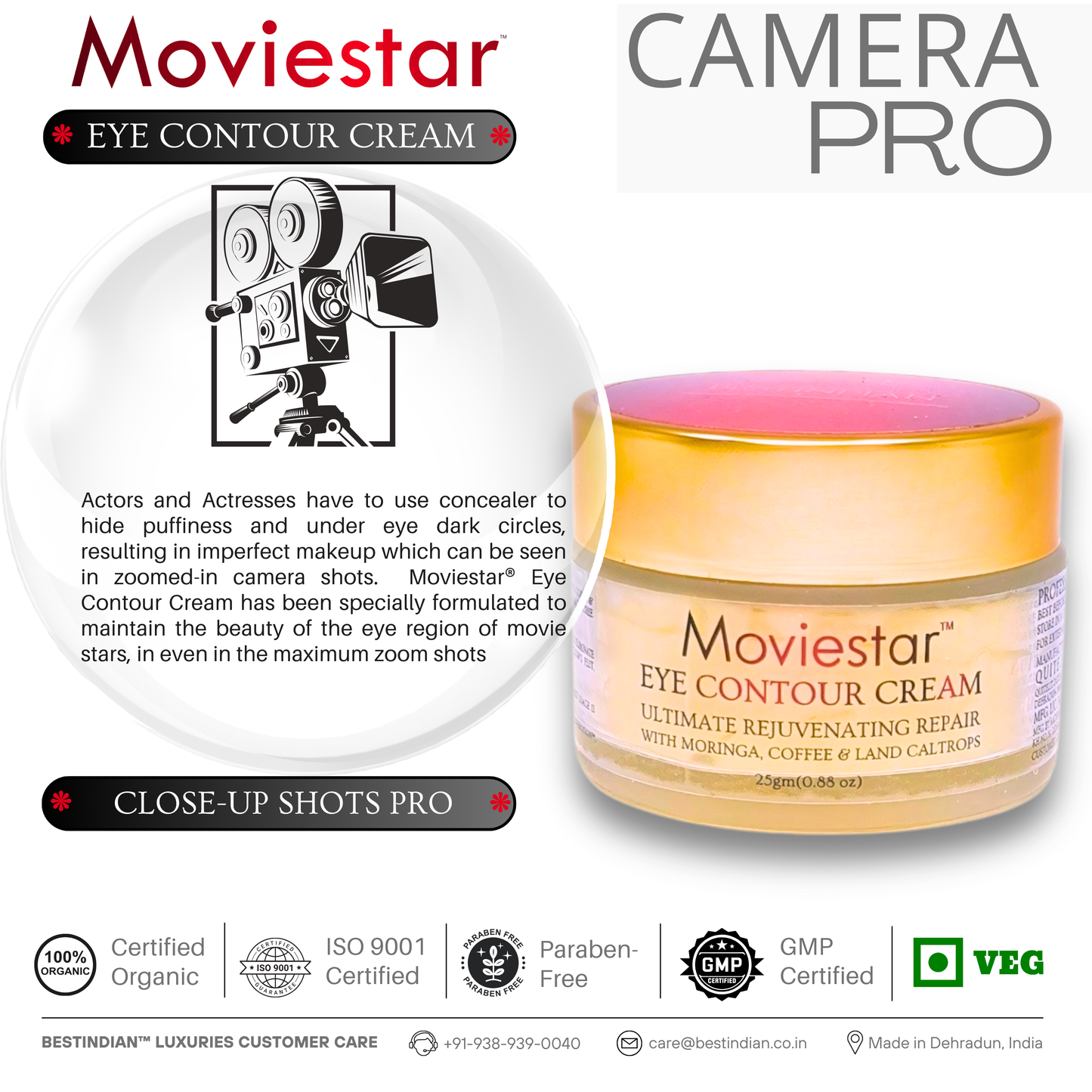
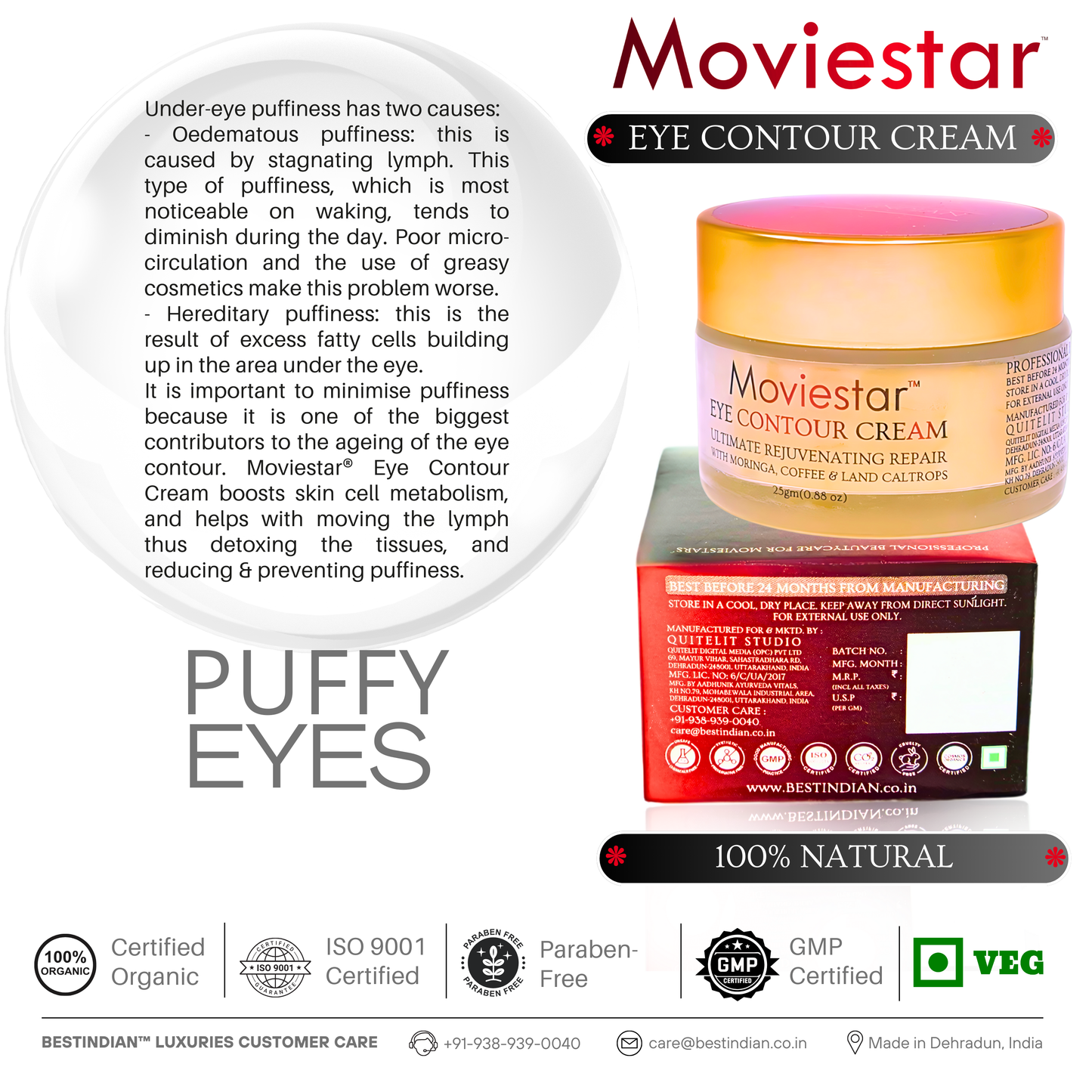
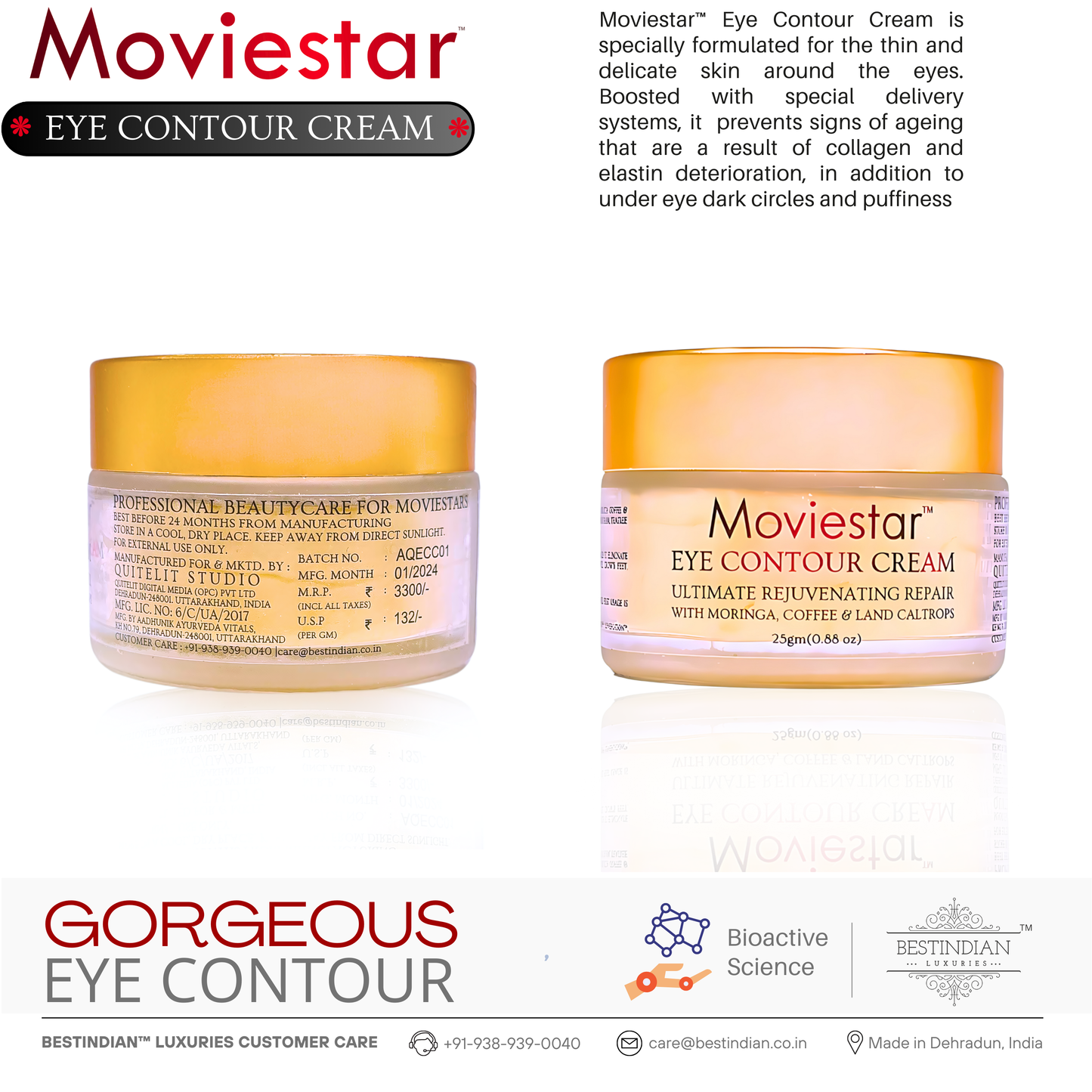
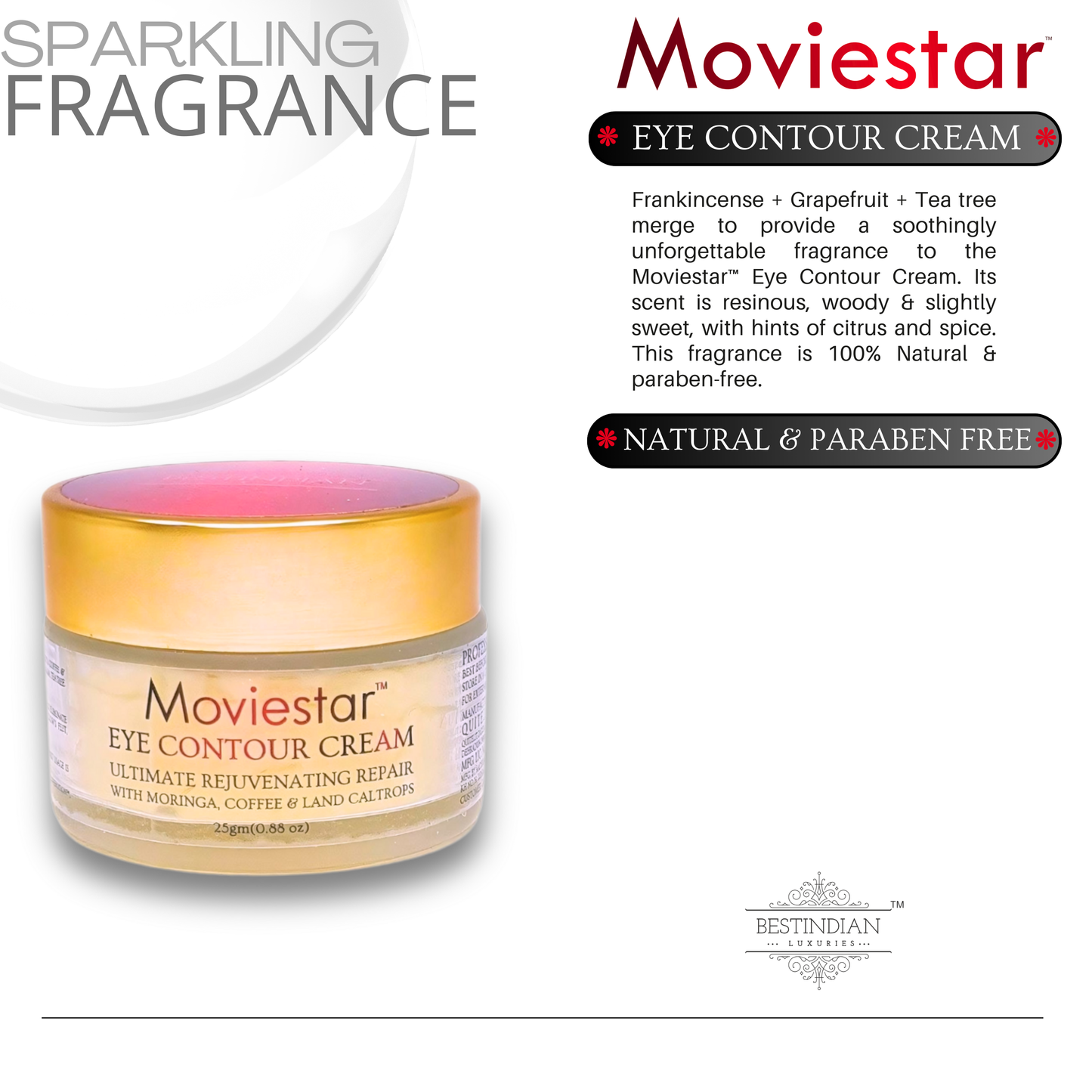
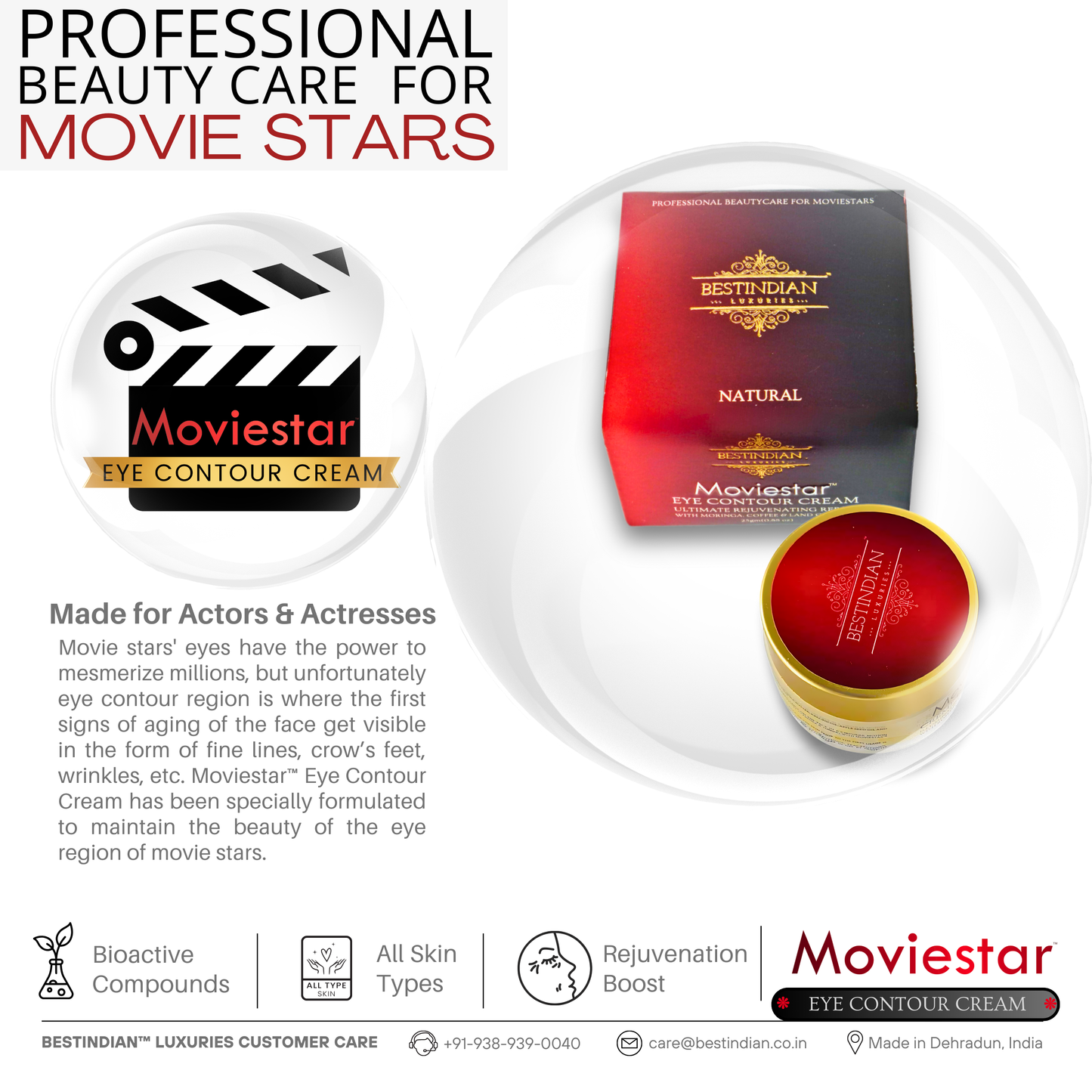
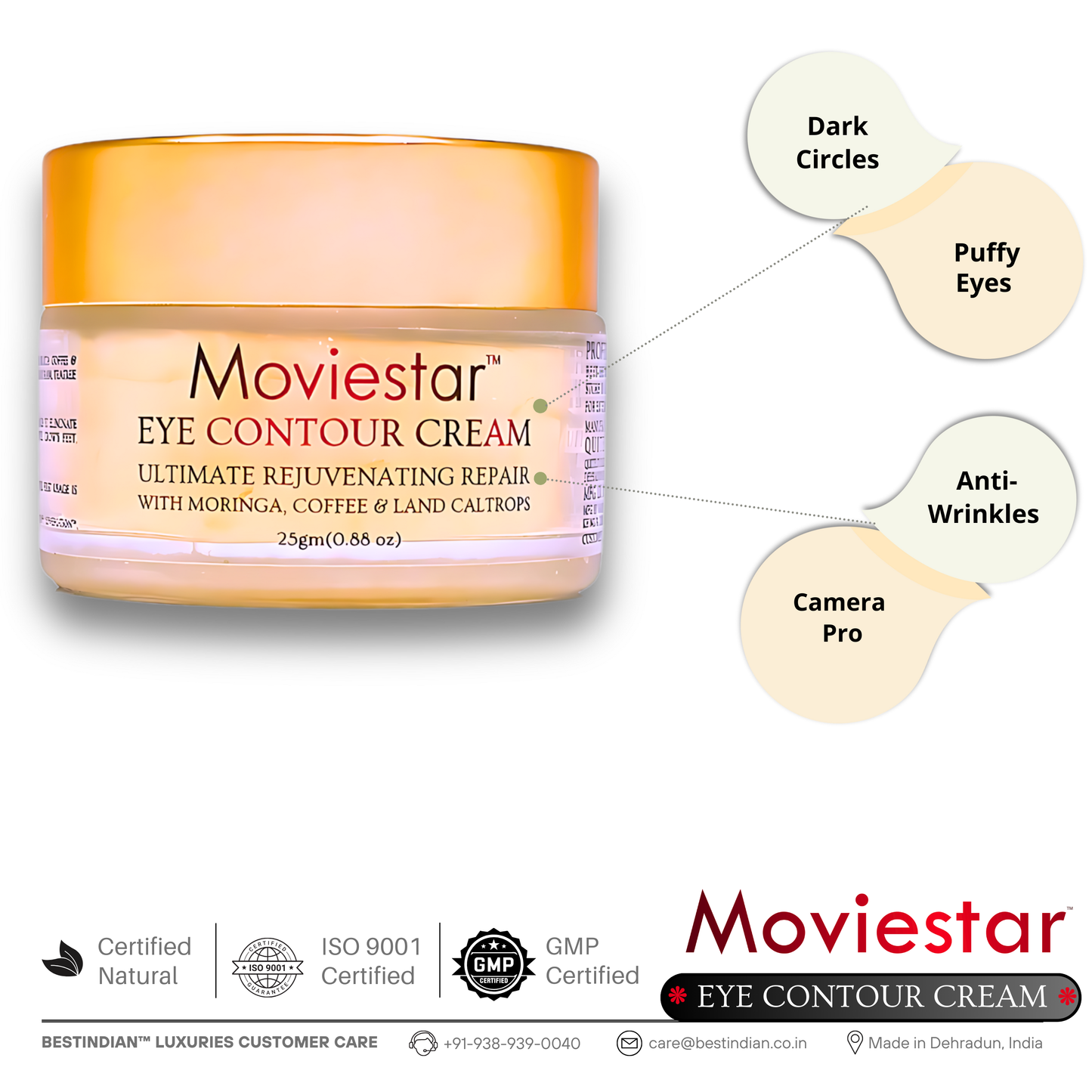
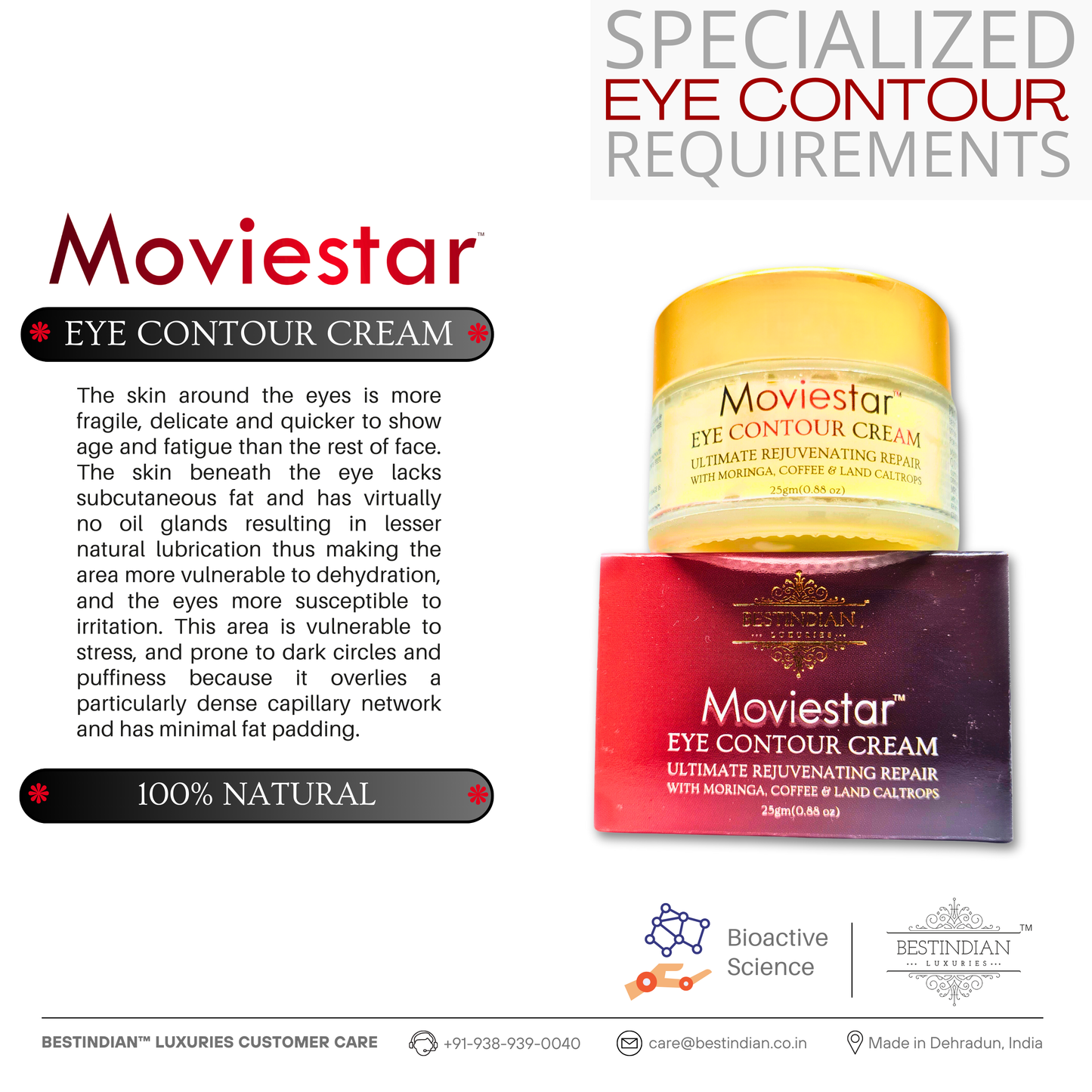
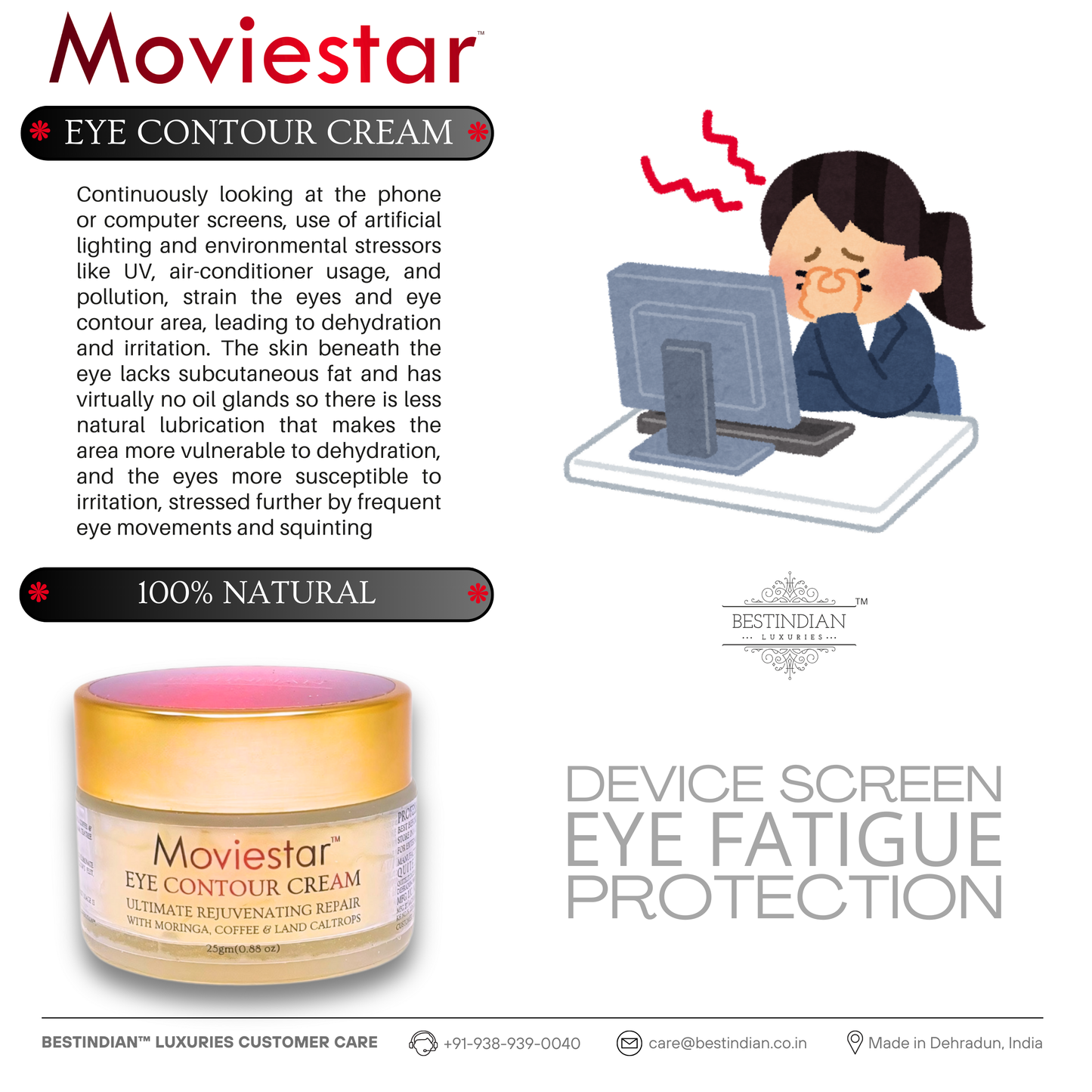
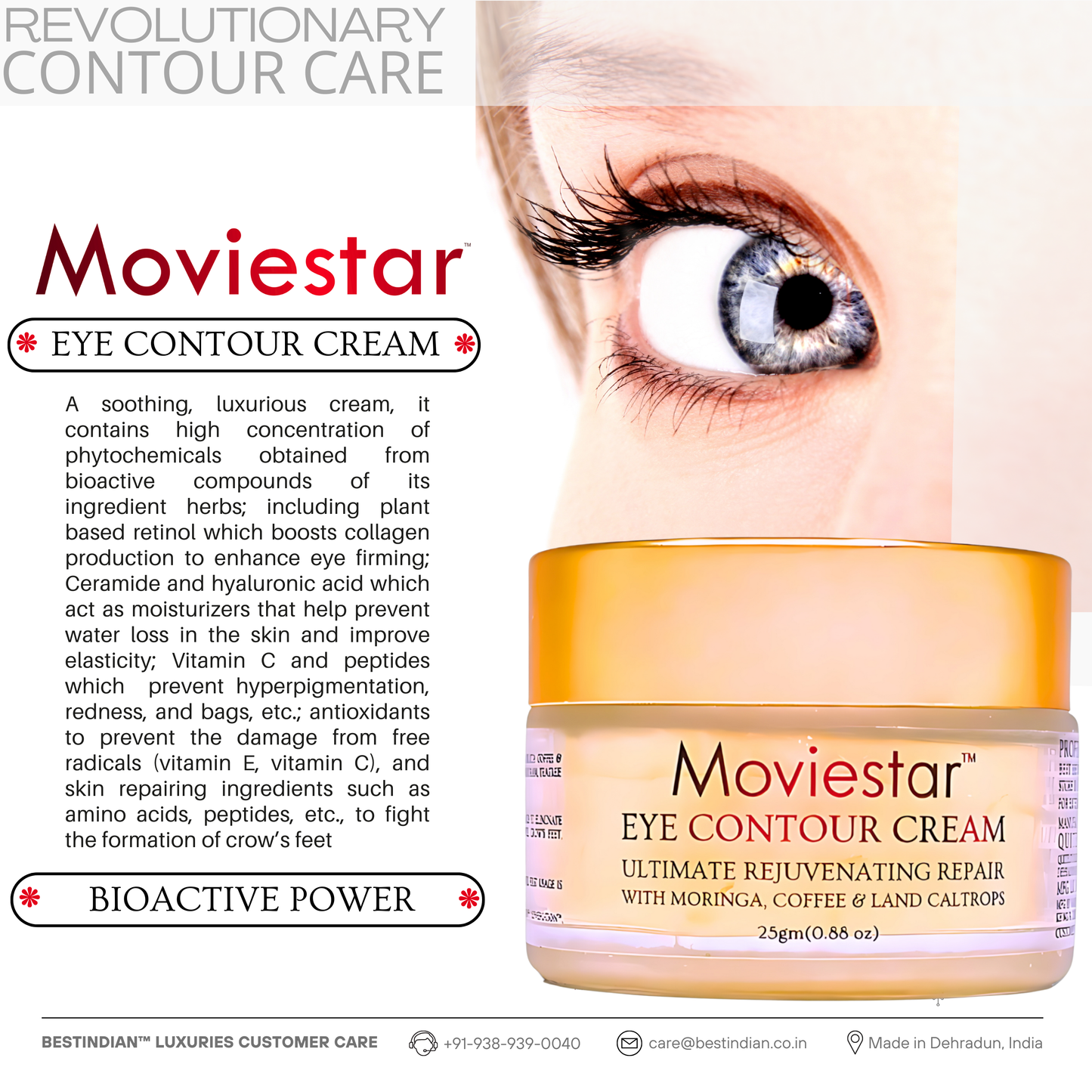
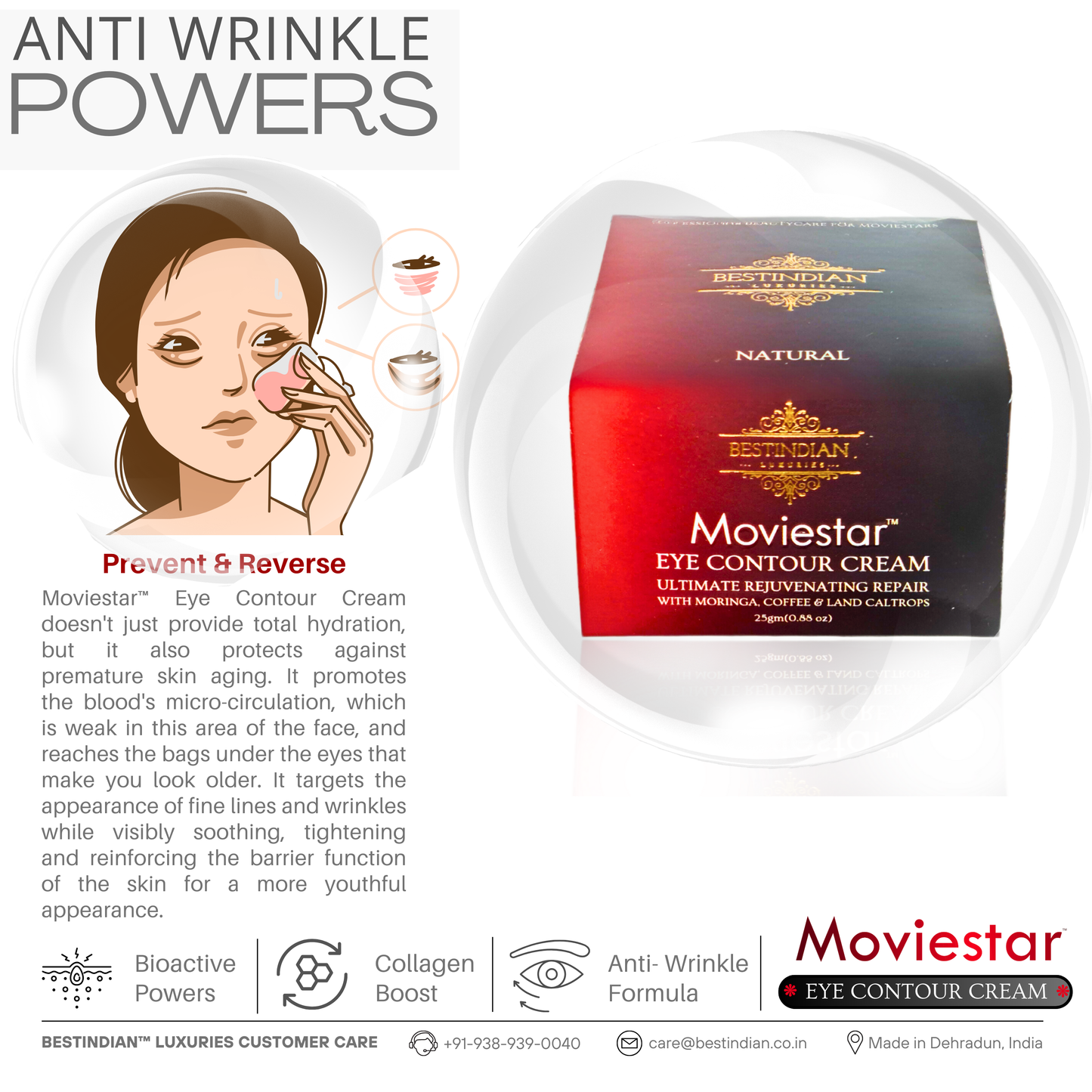
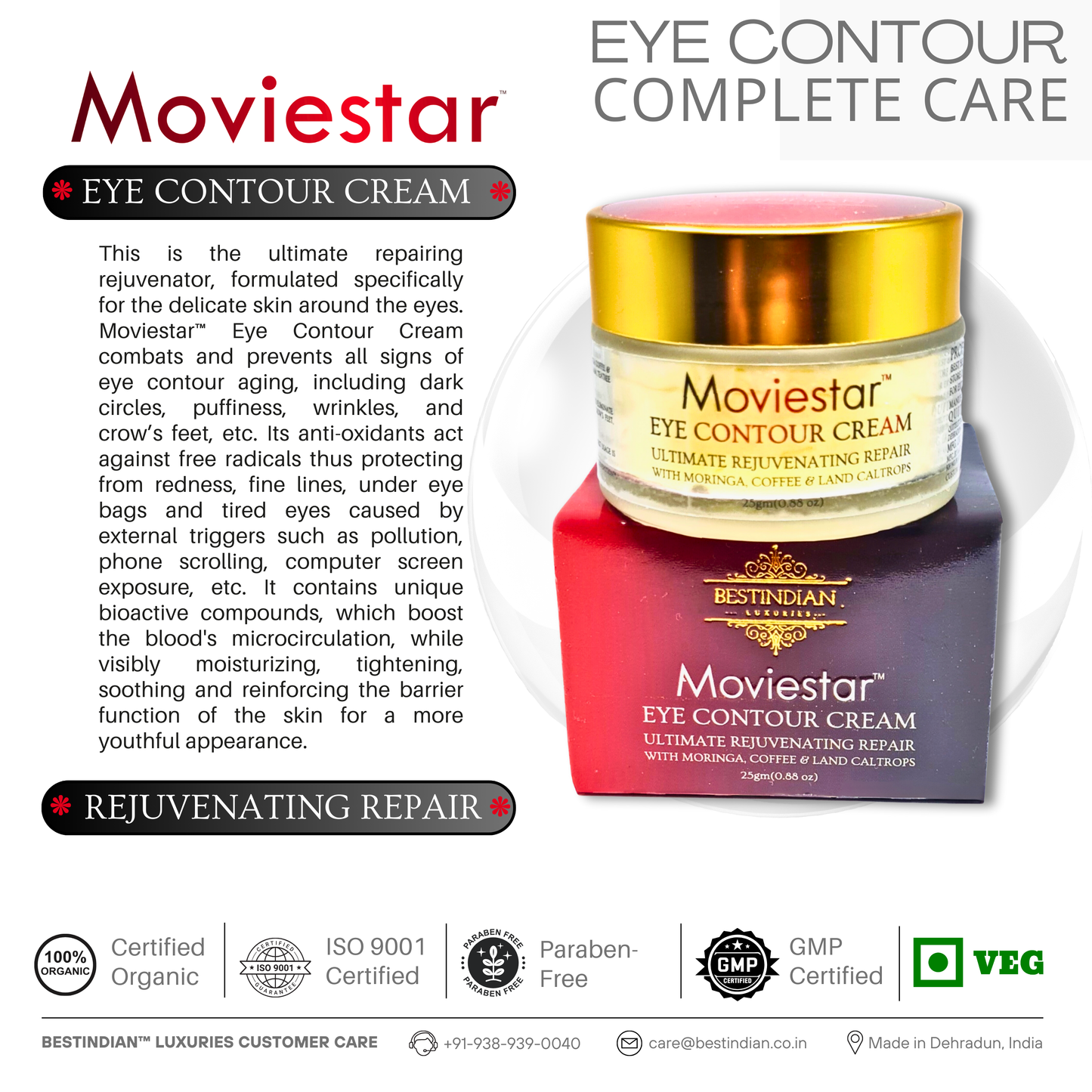
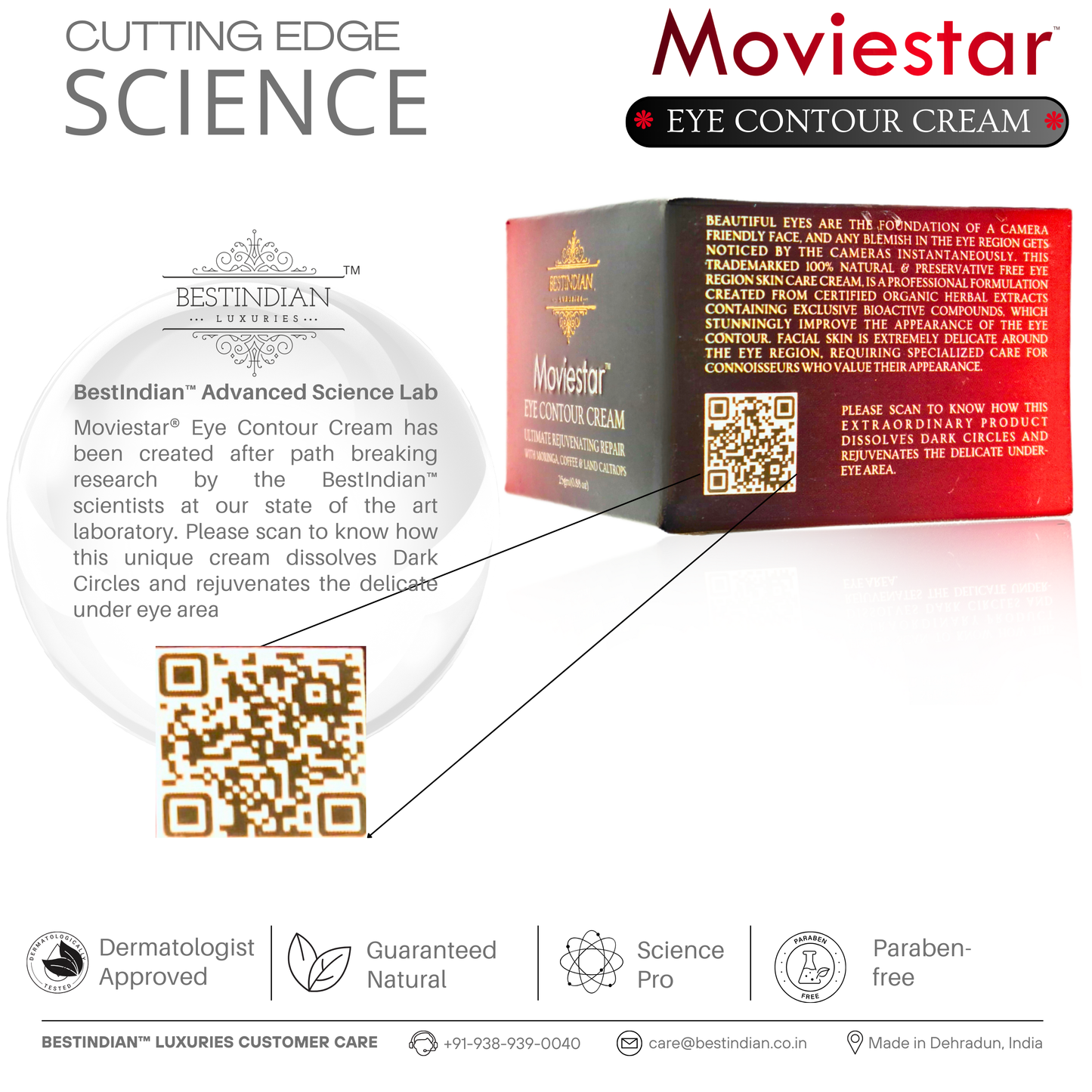
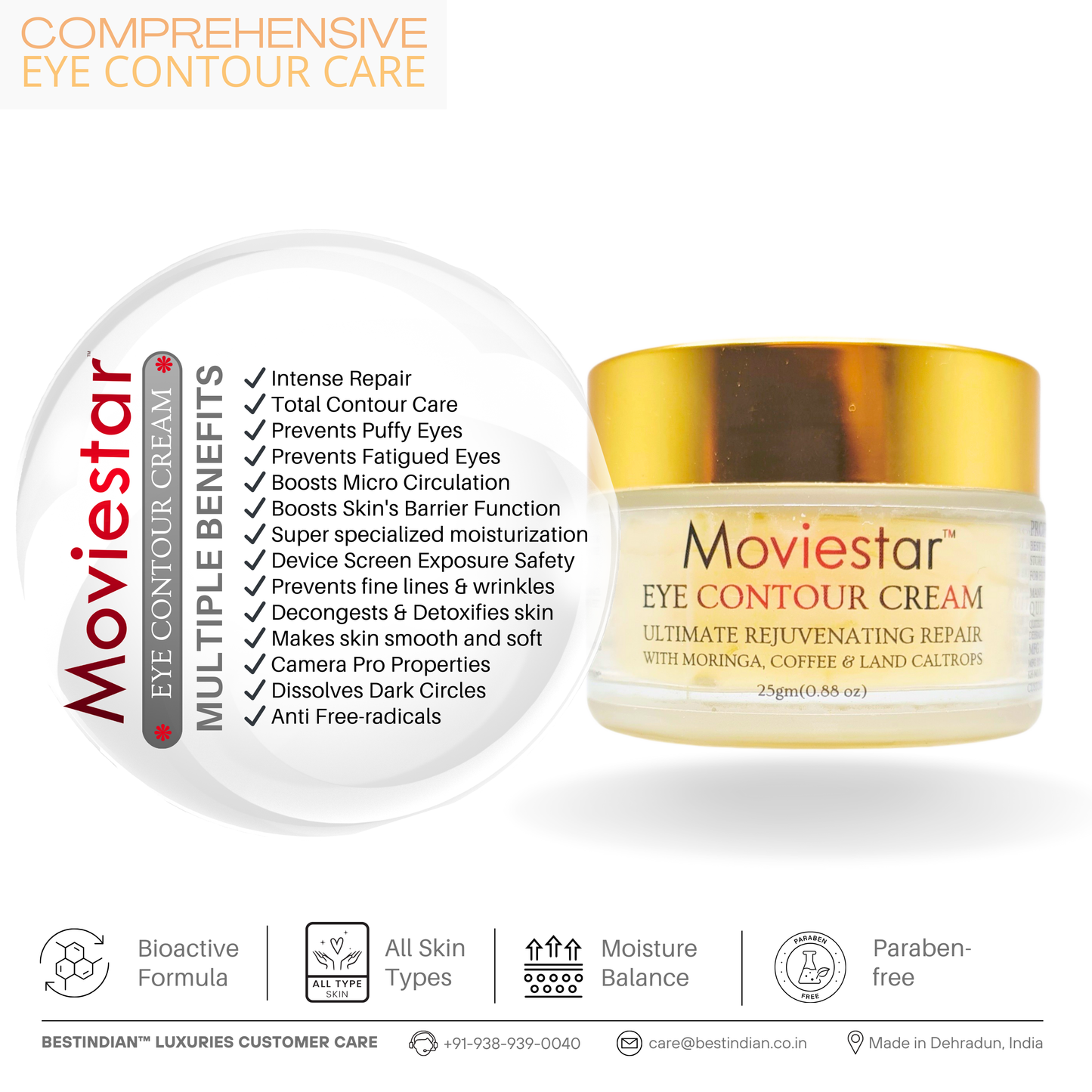
BESTINDIAN LUXURIES
The Finer Details
Why You’ll Love It
- ⚜️ Visibly Reduces Dark Circles & Puffiness — Our Coffee-infused formula is designed to energize the eye area, diminishing the appearance of under-eye bags and dark circles for a brighter, more rested look.
- ⚜️ Smooths the Look of Fine Lines & Crow’s Feet — Powered by a natural retinol alternative from botanicals like Moringa, this cream helps improve the appearance of skin elasticity and firmness, smoothing expression lines.
- ⚜️ Provides Intense, Lightweight Hydration — Delivers deep moisture to the delicate eye area with a fast-absorbing, non-greasy texture that prevents the look of dryness.
- ⚜️ Creates a Perfect Canvas for Makeup — Hydrates and smoothes the under-eye area, helping concealer apply flawlessly and preventing it from settling into creases throughout the day.
- ⚜️ Defends Against Screen Fatigue & Stress — Packed with antioxidants to help protect the vulnerable eye area from the visible effects of daily environmental and digital stressors.
All Benefits
Reduces Visible Signs of Aging & Fatigue
- ⚜️ Firms and Tightens the Look of Skin: Formulated with ingredients known to support collagen and elastin, helping to improve the appearance of skin firmness and elasticity.
- ⚜️ Smooths the Appearance of Wrinkles & Crow's Feet: Helps to restore a plump look and revitalizes the skin's surface, diminishing the visible effects of expression lines and fine wrinkles.
- ⚜️ Reduces Visible Puffiness: Helps to minimize the appearance of under-eye puffiness, creating a smoother, less tired, and more refreshed look.
Brightens & Evens Tone
- ⚜️ Diminishes the Look of Dark Circles: Helps to brighten the under-eye area, visibly reducing the appearance of dark circles for a more rested and vibrant look.
- ⚜️ Promotes a Youthful Glow: Rejuvenates the look of the skin, helping to remove the appearance of dullness and fatigue associated with tired eyes.
Hydrates & Protects the Delicate Eye Area
- ⚜️ Provides Specialized Hydration: Delivers essential moisture specifically for the delicate eye contour, preventing the look of dryness and flakiness.
- ⚜️ Soothes & Protects: Packed with natural antioxidants and calming ingredients to comfort the under-eye area and help counteract the visible effects of environmental damage.
- ⚜️ Builds Skin Resilience: Specifically targets the vulnerable under-eye skin to add resilience against daily irritants.
Creates a Flawless Canvas
- ⚜️ Primes for Flawless Makeup Application: Creates a smooth, hydrated surface that helps concealer apply evenly and prevents it from settling into expression lines throughout the day.
- ⚜️ Features a Super-Light Texture: Possesses a lightweight, non-irritating texture that is formulated for super-fast and deep absorption without a greasy feel.
Your Ritual & Care
The Eye Contour Ritual
The skin around your eyes is the most delicate on your face. This ritual is designed to be gentle, effective, and restorative. For optimal results, use consistently twice a day.
- Prepare the Canvas: Begin with a thoroughly cleansed and toned face. For an extra boost of hydration, you may gently dab the under-eye area with a cool, damp cloth before application.
- Dispense: Using your ring finger, take a single, pea-sized amount of the cream. This is enough for both eyes.
- Apply with a Delicate Touch: Gently tap the cream around your eye contour, starting from the innermost corner and moving outward along the orbital bone. Avoid pulling or rubbing the skin.
- Absorb: Allow the cream a minute to fully absorb before applying makeup. Its lightweight texture creates a smooth base, helping concealer apply evenly without settling into fine lines.
Ideal For
- ⚜️ All skin types, and specifically formulated for both women and men.
- ⚜️ Professionals, actors, and anyone looking to combat the visible signs of screen fatigue, travel, and long makeup wear.
- ⚜️ Individuals who wish to address or prevent the appearance of dark circles, puffiness, fine lines, and crow's feet.
- ⚜️ Proactive individuals in their 20s seeking to prevent the first signs of aging in the delicate eye area.
Product Care & Safety
- ⚜️ Store in a cool, dry place away from direct sunlight.
- ⚜️ A patch test on a small area of skin is recommended prior to first use.
- ⚜️ For external use only. Best before 24 months from manufacturing.
Explore More
- ⚜️ Explore Ayurvedic anti-aging skincare in the Elixir Of Youth™ Collection →
- ⚜️ Discover the Complete Moviestar™ Collection
A natural, Ayurvedic eye cream for dark circles, puffiness & fine lines — trusted by professionals, loved by movie stars.
Fragrance
An Unforgettable Aromatic Profile
The fragrance of the Moviestar™ Eye Contour Cream is a sophisticated, 100% natural blend designed to be both soothing and unforgettable. It is crafted from the following pure essential oils to create a unique sensory ritual.
⚜️ Frankincense (The Soothing Heart)
At its core is the rich, resinous aroma of Frankincense. This ancient and luxurious note provides a warm, slightly spicy, and meditative scent that instantly soothes the senses.
⚜️ Grapefruit (The Bright Top Note)
A bright top note of Grapefruit provides a burst of clean, zesty citrus. This uplifting element prevents the fragrance from being heavy, adding a touch of energy and light.
⚜️ Tea Tree (The Purifying Undertone)
A subtle, clean undertone of Tea Tree adds a final touch of purity. Its fresh and herbaceous scent reinforces the formula's efficacy and leaves the senses feeling clarified and refreshed.
Ingredient Transparency
Our Promise of 100% Transparency
We believe you have a right to know exactly what you are putting on your skin. BestIndian™ practices radical transparency and guarantees that no other ingredient, apart from those listed below, has been used in this 100% natural and synthetic chemical-free luxury formula.
Full Ingredient List (INCI)
Almond (Prunus Amygdalus Dulcis) Oil, Pomegranate (Punica Granatum) Seed Oil, Moringa (Moringa Oleifera) Oil Infused With Robusta Coffee & Land Caltrops (Tribulus Terrestris), Shea Butter (Butyrospermum Parkii), Frankincense (Boswellia Carterii) Essential Oil, Marjoram (Origanum Majorana) Essential Oil, Tea Tree (Melaleuca Alternifolia) Essential Oil, Grapefruit (Citrus Paradisi) Essential Oil.
Ingredient Deep Dive
⚜️ Moringa Oil (Moringa Oleifera): The Rejuvenator
A cornerstone of Ayurvedic skincare, Moringa oil is celebrated for its high concentration of antioxidants and phenolics. These bioactive compounds are known to offer powerful protection against the environmental stressors that can lead to the breakdown of collagen and elastin, helping to visibly revitalize the skin for a more youthful appearance.
⚜️ Robusta Coffee (Coffea Canepora): The Puffiness Reducer
The natural caffeine in Robusta Coffee is renowned for its ability to energize the skin. When applied to the eye contour, it helps to support micro-circulation, which can visibly reduce the appearance of puffiness and under-eye bags for a smoother, more awake look.
⚜️ Pomegranate Seed Oil (Punica Granatum): The Brightener
This luxurious oil is a potent source of antioxidants and punicic acid. It is traditionally used to help protect the delicate skin from environmental damage and is known to improve the appearance of skin tone, making it invaluable for addressing the look of dark circles.
⚜️ Almond Oil (Prunus Amygdalus Dulcis): The Deep Nourisher
Rich in Vitamin E and essential fatty acids, Almond Oil is a classic emollient that provides deep, lasting nourishment. It helps to hydrate the delicate under-eye skin, preventing the look of dryness and flakiness while promoting a soft, supple texture.
⚜️ Land Caltrops (Tribulus Terrestris): The Firming Agent
A unique botanical used for centuries in traditional medicine, Land Caltrops contains saponins and other bioactive compounds. In skincare, it is known for its ability to improve the appearance of skin firmness, making it a key ingredient for targeting the look of fine lines and crow's feet.
⚜️ Shea Butter (Butyrospermum Parkii): The Barrier Protector
A superior, non-comedogenic moisturizer that helps to fortify the skin’s natural protective barrier. By creating a breathable layer, Shea Butter locks in essential moisture, improves the look of elasticity, and helps defend the delicate eye area from daily irritants.
⚜️ Frankincense Essential Oil (Boswellia Carterii): The Soothing Resin
An ancient and revered ingredient, Frankincense is celebrated for its soothing and calming properties. It helps to reduce the appearance of redness and skin stress, making it ideal for the sensitive eye contour area.
⚜️ Marjoram Essential Oil (Origanum Majorana): The Calming Comfort
Known for its warm, comforting aroma and calming properties, Marjoram helps to soothe and relax the skin, reducing the visible signs of daily fatigue.
⚜️ Tea Tree Essential Oil (Melaleuca Alternifolia): The Purifying Touch
A renowned natural purifier, a subtle touch of Tea Tree oil helps to keep the delicate skin around the eyes clear and balanced without causing irritation.
⚜️ Grapefruit Essential Oil (Citrus Paradisi): The Brightening Boost
This vibrant oil provides a final brightening boost. Its natural properties help to promote a more luminous and even-toned appearance, leaving the eye area looking refreshed and energized.
Formulated Without
Parabens, Sulfates, Phthalates, Silicones, Synthetic Fragrances, Mineral Oil, and Chemical Preservatives.
Frequently Asked Questions
1. How is this eye cream different from a standard face moisturizer?
⚜️ The Moviestar™ Eye Contour Cream is specifically formulated for the unique, delicate skin around the eyes, which is up to 10 times thinner than the rest of the face. It uses a super-lightweight texture for fast absorption and contains a targeted concentration of botanicals like Coffee and Moringa to address specific eye-area concerns like puffiness and dark circles.
2. Does this cream contain synthetic Retinol?
⚜️ No. Our 100% natural formula provides Provitamin A (a natural retinol alternative) from Rosehip and other botanicals. This offers the visible benefits of smoother, firmer-looking skin without the harshness, redness, or peeling often associated with synthetic retinoids.
3. Will this help with dark circles, puffiness, and crow's feet?
⚜️ Yes. It is a multi-action formula. Ingredients like Coffee and Moringa help to visibly reduce puffiness and the appearance of dark circles. The natural Provitamin A and other botanicals support the skin's collagen, which helps to smooth the look of fine lines and crow’s feet.
4. Can this help with tired eyes from screen fatigue?
⚜️ Absolutely. It was designed for the modern professional. The formula is packed with antioxidants from Moringa and Pomegranate Seed Oil that help defend against the visible effects of digital and environmental stressors from prolonged phone and computer use.
5. Is this eye cream suitable for sensitive skin?
⚜️ Yes. It is lightweight, preservative-free, and formulated with calming botanicals like Moringa and Shea Butter specifically to soothe and comfort the delicate under-eye skin without causing irritation.
6. Can men use this eye cream?
⚜️ Yes. It is a unisex formula designed to address universal concerns like dark circles, puffiness, and wrinkles that affect both men and women.
7. Can I use this under makeup?
⚜️ Yes. Its lightweight texture absorbs quickly to hydrate and smooth the under-eye area, creating the perfect canvas for concealer and helping to prevent it from creasing throughout the day.
8. When should I start using an eye cream?
⚜️ While many people start in their 30s, the best results come from prevention. We recommend incorporating a specialized eye cream into your routine in your early-to-mid 20s to help protect the delicate skin and prevent the premature appearance of fine lines.
9. How long until I see visible results?
⚜️ Many users notice reduced puffiness and improved hydration within the first 1-2 weeks. More significant improvements in the appearance of fine lines and dark circles typically become more noticeable after 6-8 weeks of consistent nightly use.
The Science & Sensory Experience
The Science & Sensory Experience
The under-eye area is the first to show signs of fatigue and aging—fine lines, dark circles, puffiness—which is why it demands specialized care. Our potent, bioactive formula is engineered to deliver key nutrients to the delicate eye contour. The texture is a luxurious, lightweight cream that absorbs instantly, leaving a smooth, hydrated finish. The subtle, soothing aroma of Frankincense, Grapefruit, and Tea Tree makes each application a calming, restorative ritual.
The Science of the Eye Contour: Why This Area Ages First
The skin around your eyes is fundamentally different from the rest of your face. It is up to 10 times thinner, has virtually no oil glands for natural lubrication, and contains less subcutaneous fat for cushioning. This unique physiology makes it incredibly delicate, more prone to dryness, and the first place to show visible signs of fatigue and aging. Compounded by thousands of daily muscle movements from blinking and expressions, this fragile area requires highly specialized care.
This cream is engineered to address the three core challenges of the eye contour area:
⚜️ The Challenge of Dark Circles
Dark circles are often a complex issue. They can be hereditary, caused by an overproduction of melanin creating a hyperpigmented, brownish appearance. They can also be circulatory, where poor micro-circulation and thin, translucent skin can make the underlying blood vessels more visible, creating a bluish tint. Lifestyle factors like fatigue, allergies, and screen time can exacerbate their appearance.
⚜️ The Challenge of Puffiness
Under-eye puffiness is typically caused by temporary fluid retention (oedema), which is why eyes can appear swollen in the morning after the muscles have been at rest. Over time, this repeated swelling can stretch the skin. A secondary cause is hereditary, involving the natural fat pads under the eyes becoming more prominent with age.
⚜️ The Challenge of Fine Lines & Wrinkles
The constant movement from squinting and expressions, combined with the natural depletion of collagen and elastin, leads to the formation of "crow's feet" and fine lines. Because the skin is so thin and dry in this area, these lines can appear much earlier and more pronounced than on other parts of the face.
The Moviestar™ Solution: A Targeted, Multi-Action Formula
A simple moisturizer is not enough. The Moviestar™ Eye Contour Cream is a multi-action treatment specifically formulated for the delicate periorbital skin. Its bioactive ingredients, including antioxidants and natural emollients, are delivered in a super-light, fast-absorbing texture. The formula works to deeply hydrate, soothe, and support the skin's barrier, while its key botanicals are known to improve the appearance of firmness, brightness, and texture, addressing the visible signs of dark circles, puffiness, and wrinkles for a revitalized, more youthful look.
Star Ingredients
-

Moringa
⚜️ An Ayurvedic powerhouse packed with antioxidants to help protect the skin from environmental stressors and revitalize its appearance. Moringa oleifera enhances skin revitalization effect and supports anti-aging skin effects. Moringa phenolics include kaempferol, quercetin, rutin, gallic, chlorogenic, ellagic and ferulic acid and antioxidants, include vitamin A, C and B. Phenolics offer the best protection against enzymes that cause the breakdown of collagen and elastin in skin.
-

Coffee
⚜️ A natural source of caffeine known to energize the skin and help reduce the appearance of puffiness and under-eye bags. It contains bioactive compounds such as alkaloids (caffeine, trigonelline), phenolics (chlorogenic acid, epicatechin, catechin, rutin, protocatechuic acid and ferulic acid) and polymers (melanoidins), etc., which exhibit antioxidant, anti-inflammatory, anti microbial, and anti-aging properties. It helps dilate blood vessels that contribute to dark circles
-

Land Caltrops
Tribulusterrestris contains saponins, which, after hydrolysis, yield the sapogenins diosgenin, gitogenin, chlorogenin, ruscogenin, 25D-spirosta-3 and 5-diene, among others. It contains the carboline alkaloids harmane and harmine; Siloxane derivatives, fatty acid esters, diisooctyl phthalate, phytosterol, and aromatic acid esters as the major compounds.

Trust & Transparency
The BestIndian™ Promise
At BestIndian™, we believe luxury is defined by authenticity & efficacy. Our philosophy marries the timeless wisdom of Ayurveda with the precision of modern science. We disclose all ingredients used in every product we make, because your trust is our most valued asset.
⚜️
Our Promise: Formulated with 100% natural and certified organic ingredients. Always free from preservatives, parabens, and sulfates. Vegetarian and vegan friendly. No hidden ingredients.
⚜️
Our Certifications: Manufactured in a GMP, ISO & COSMOS Organic certified, carbon-neutral, cruelty-free facility amidst pollution-free environment of the Himalayas in Dehradun, India
OUR BRANDS
-

Moviestar™ – Luxury Ayurvedic Skincare brand by BestIndian™
Luxury skincare designed for professional actors. Moviestar™ by BestIndian™ is a premium...
-

GlowPotion™ – Natural Ayurvedic Skincare brand by BestIndian™
The pinnacle of beauty is a complexion that requires no makeup to...
-

The Elixir of Youth™ Collection for Anti-Aging & Wrinkle Repair
Welcome to Elixir of Youth™- scientifically created, high-performance Ayurvedic formulations designed by...
